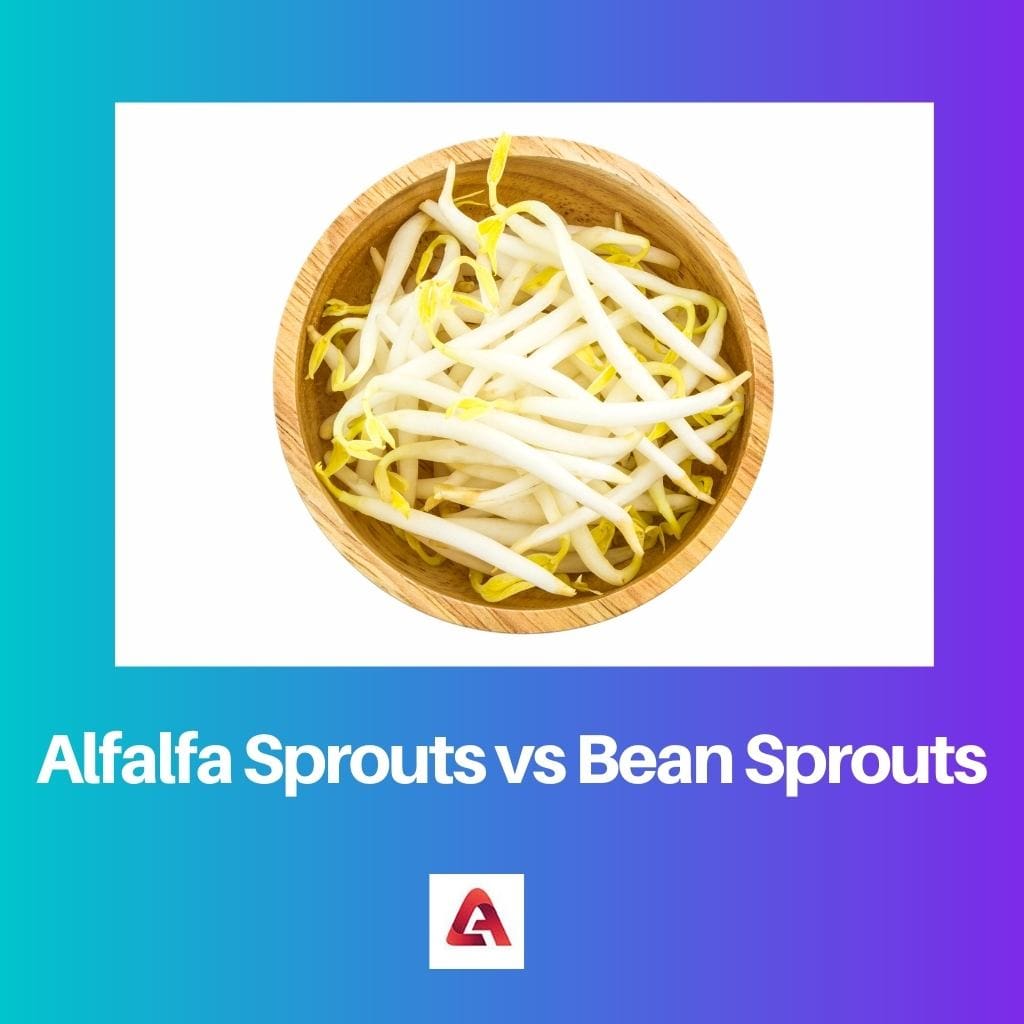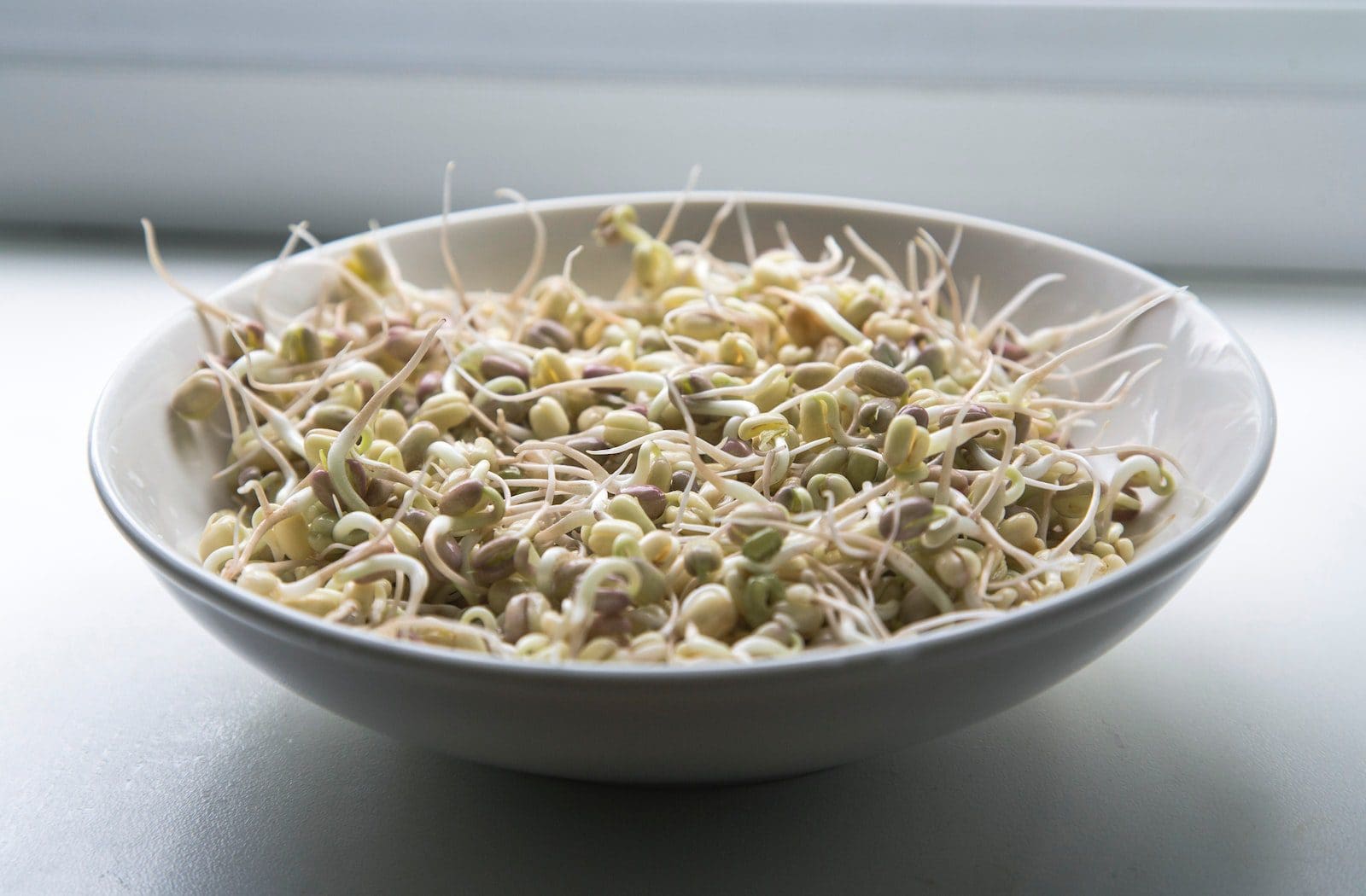Alfalfa, with its mild and nutty flavor, offers a rich source of vitamins and minerals, promoting overall health. On the other hand, bean sprouts boast a crisp texture and a slightly sweeter taste, contributing a distinct crunch to dishes.
Key Takeaways
- Alfalfa sprouts are made from the seeds of the alfalfa plant, while bean sprouts are made from the seeds of the mung bean or soybean.
- Alfalfa sprouts are smaller and more delicate than bean sprouts, with a slightly sweet and nutty flavor.
- While both alfalfa and bean sprouts are nutritious and can be used in various dishes, they have different textures and flavor profiles.
Alfalfa Sprouts vs Bean Sprouts
The difference between alfalfa sprouts and bean sprouts is that alfalfa sprouts are thinner, less crunchy, and more delicate compared to thicker bean sprouts which are more crunchy and toasty.
Apart from being consumed by humans, Alfalfa sprouts are also consumed by livestock and are costlier than bean sprouts.

Also, alfalfa sprouts have lesser protein content and take more time to sprout compared to bean sprouts.
Comparison Table
| Feature | Alfalfa Sprouts | Bean Sprouts |
|---|---|---|
| Type of Sprout | Legume | Legume (Varies – Mung bean, lentil, soybean) |
| Taste | Mild, slightly grassy | Varies depending on the bean – Mung bean sprouts have a neutral taste, while lentil and soybean sprouts can be slightly nutty. |
| Texture | Crunchy and delicate | Crunchy and slightly firmer than alfalfa sprouts |
| Color | Light green | Varies – Mung bean sprouts are white or yellowish, lentil sprouts are brown, and soybean sprouts are green. |
| Nutrient Focus | Vitamins A, C, K, and minerals like calcium and iron | Protein, fiber, and Vitamin C |
| Protein Content | Lower | Higher |
| Calories | Lower | Higher |
| Culinary Uses | Salads, sandwiches, wraps, smoothies | Salads, stir-fries, soups, noodle dishes |
| Availability | Widely available | Can be less readily available depending on the bean type |
| Storage | Up to 5 days in the refrigerator | Up to 3-5 days in the refrigerator |
What are Alfalfa Sprouts?
Alfalfa sprouts are young shoots that germinate from alfalfa seeds (Medicago sativa). These sprouts are commonly used as a nutritious addition to salads, sandwiches, and various dishes. They have a mild, fresh flavor and a crisp texture, making them a popular choice for enhancing the nutritional profile and taste of various meals.
Germination Process
- Seed Soaking: Alfalfa seeds are soaked in water for several hours to initiate the germination process. This step helps sthe outer seed coat and triggers the enzymes necessary for sprouting.
- Rinsing and Draining: After soaking, the seeds are rinsed and drained regularly. This prevents the growth of mold or bacteria and ensures proper moisture levels for germination.
- Sprouting: The seeds are placed in a sprouting container or tray, allowing them to germinate and grow into tiny, tender sprouts. This phase takes a few days and involves keeping the seeds in a humid environment.
Nutritional Benefits
- Rich in Vitamins and Minerals: Alfalfa sprouts are a good source of vitamins A, B, C, E, and K. They also contain essential minerals like calcium, magnesium, and potassium.
- High in Antioxidants: These sprouts are known for their antioxidant properties, which help combat oxidative stress and reduce the risk of chronic diseases.
- Low in Calories: Alfalfa sprouts are low in calories, making them a healthy option for those looking to manage their weight.
Health Considerations
- Potential Contamination Risk: Due to their moist growing environment, alfalfa sprouts can be susceptible to bacterial contamination, particularly with pathogens like Salmonella and E. coli. It’s essential to handle and store them properly to minimize the risk of foodborne illnesses.
- Pregnancy Precautions: Pregnant women are advised to avoid consuming raw alfalfa sprouts due to the potential risk of foodborne illnesses. Cooking the sprouts can reduce this risk.
Culinary Uses
- Salads: Alfalfa sprouts add a crunchy texture and a nutritional boost to salads, enhancing both flavor and visual appeal.
- Sandwiches and Wraps: They are commonly used as a filling or topping for sandwiches, wraps, and rolls, providing a fresh and light element to the dish.
- Smoothies: Some people incorporate alfalfa sprouts into smoothies for an extra nutrient kick, blending them with fruits and vegetables.

What are Bean Sprouts?
Introduction
Bean sprouts are young, tender shoots that emerge from germinated beans. These crunchy, fresh sprouts are commonly used in various cuisines worldwide, adding a delightful texture and a nutritional boost to dishes. Let’s delve into the details of bean sprouts, exploring their origin, nutritional content, culinary uses, and potential health benefits.
Origins and Varieties
Bean sprouts can be derived from a variety of beans, including mung beans, soybeans, alfalfa seeds, and more. The most common type is mung bean sprouts, recognized for their crisp texture and mild flavor. Each variety brings its unique taste and nutritional profile to the table.
Nutritional Content
Bean sprouts are a powerhouse of nutrients, making them a healthy addition to your diet. They are rich in vitamins, minerals, and enzymes. Here’s a breakdown of their nutritional content:
1. Vitamins
Bean sprouts are a good source of vitamins such as vitamin C, vitamin K, and various B vitamins, including folate. These vitamins play crucial roles in immune function, blood clotting, and energy metabolism.
2. Minerals
Essential minerals like iron, magnesium, phosphorus, and potassium are present in bean sprouts. These minerals contribute to bone health, muscle function, and overall well-being.
3. Protein
Bean sprouts are a notable plant-based protein source. They contain all the essential amino acids, making them a valuable addition to vegetarian and vegan diets.
4. Fiber
Fiber content in bean sprouts supports digestive health and helps maintain a feeling of fullness, making them a great choice for those aiming to manage their weight.
Culinary Uses
Bean sprouts are incredibly versatile and can be used in various culinary applications. They add a crisp texture and mild, fresh flavor to salads, stir-fries, sandwiches, and wraps. Additionally, bean sprouts are commonly used in Asian cuisines, such as Chinese, Korean, and Thai, where they are incorporated into noodle dishes and spring rolls.
Health Benefits
Consuming bean sprouts offers several health benefits:
1. Antioxidant Properties
The rich vitamin and mineral content in bean sprouts provides antioxidant properties, helping to combat oxidative stress in the body.
2. Weight Management
Due to their low calorie and high fiber content, bean sprouts can contribute to a feeling of fullness, potentially aiding in weight management.
3. Blood Sugar Regulation
The fiber and nutrients in bean sprouts may play a role in regulating blood sugar levels, making them a good choice for individuals with diabetes.

Main Differences Between Alfalfa Sprouts and Bean Sprouts
Alfalfa Sprouts:
- Plant Source:
- Derived from alfalfa seeds.
- Flavor:
- Mild, nutty flavor.
- Texture:
- Delicate and tender.
- Nutrient Profile:
- Rich in vitamins C and K, folate, and minerals like manganese.
- Appearance:
- Thin, green shoots with tiny leaves.
- Culinary Use:
- Often used in salads, sandwiches, wraps, and garnishes.
- Growing Time:
- Typically sprout in 3-5 days.
Bean Sprouts:
- Plant Source:
- Derived from various types of beans, such as mung beans or soybeans.
- Flavor:
- Mild and slightly sweet.
- Texture:
- Crunchy and crisp.
- Nutrient Profile:
- Good source of protein, fiber, vitamins C and A, and minerals like iron.
- Appearance:
- Thicker, cylindrical sprouts with a pale color.
- Culinary Use:
- Commonly used in Asian cuisine, stir-fries, soups, and salads.
- Growing Time:
- Typically sprout in 4-7 days.

- https://www.sciencedirect.com/science/article/pii/S0740002018309006
- https://www.sciencedirect.com/science/article/pii/S0956713507001533
- https://pubs.acs.org/doi/abs/10.1021/la020835i

It’s interesting to learn about the different uses of alfalfa and bean sprouts. They both have their advantages.
Absolutely, it’s all about preference and how you want to use them.
Definitely, they each have unique qualities that make them great.
Bean sprouts are commonly used in Asian cuisines and have a great texture for stir-fries and soups.
Yes, bean sprouts add a lovely crunch to dishes.
They’re perfect for adding some texture to the meal.
Bean sprouts are my favorite! They’re so versatile and delicious.
I prefer alfalfa sprouts, they have a unique nutty flavor that I love.
Sprouts are definitely a great source of vitamins and minerals. They’re also easy to include in your diet!
I totally agree! I love adding sprouts to my salads and sandwiches.
True, they’re healthy and add a nice crunch to dishes.
I find that alfalfa sprouts are great as a light snack or salad ingredient.
Yes, and they’re so refreshing!
They definitely bring a nice crispness to dishes.
I love alfalfa sprouts in my sandwiches, they add a refreshing touch to the flavor.
Definitely! Alfalfa sprouts give sandwiches a healthier, lighter taste.
The comparison table is very informative, it clearly outlines the differences between alfalfa and bean sprouts.
Agreed, it’s comprehensive and helpful.
I love how nutritious alfalfa and bean sprouts are. They’re a great addition to a healthy diet.
I disagree, alfalfa sprouts are too delicate for me. Bean sprouts are definitely crunchier and more satisfying.
I agree, alfalfa sprouts are too delicate for my liking as well.
I see your point, bean sprouts do have a nice crunch.
The differences in sprouting time and cost between alfalfa and bean sprouts are quite significant. I prefer bean sprouts for their quick growth and affordability.
Both alfalfa and bean sprouts have their unique benefits, but it’s understandable to prefer bean sprouts for their convenience.